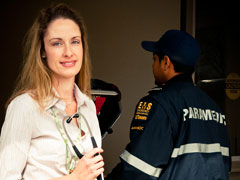Sorting it Out
By Laura Pratt
Right from the day a teacher first assigned a grade to our paper and affixed a gold star in recognition of its excellence, we all got it that a mark is meaningful, and communicates an accurate assessment of a situation. But the research efforts of Dr. Clare Atzema, a scientist in clinical epidemiology at Sunnybrook Research Institute and an assistant professor in the division of emergency medicine at the University of Toronto, are revealing that this expectation doesn't always extend to the critical moments of life.
In a medical setting, triage is a process of prioritizing patients based on the severity of their condition so as to employ limited resources effectively, treating those that need it most first. The term comes from the French verb "trier," which means "to sort," and, says Atzema, it's an inexact science that's far from perfect.
When a person shows up at an emergency department (ED), he's assigned a triage score. A nurse does a quick exam, asks a few questions about pain medication and other medical conditions, takes vital signs and allocates a "grade." In Canada, people get a score of between one and five, based on a scale—the Canadian triage and acuity scale—that was established in the mid 1990s to govern the meting out of medical care. Score a one and you'll be seen right away. "You're about to die or your heart has stopped," says Atzema. Score a five and expect to see a parade of others deemed more worthy of immediate medical attention be escorted past you over the course of an hours-long wait.
According to guidelines endorsed by the Canadian Association of Emergency Physicians, most patients who rate a one should be seen immediately; a two within 15 minutes; a three within 30 minutes; a four within an hour; and a five within two hours. The reality, Atzema says, is sometimes quite different. "You're almost always waiting longer than the guidelines recommend due to ED crowding." And the further up the scale a patient is, the more dramatic is the divergence from the prescribed wait time.
More alarming, still, is Atzema's recent discovery that about one-half of heart attack patients she looked at in a retrospective study were assigned triage scores improperly. A full 50.3% of acute myocardial infarction patients were determined by triage nurses to only warrant a three, four or five. "That's shocking," says Atzema. "Even 15 minutes is big, in terms of mortality."
Indeed, given that six million patients with chest pains are evaluated in U.S. EDs each year, it's vital that those people whose discomfort is associated with a bona-fide heart attack are appropriately identified and that time-sensitive treatments are rapidly administered. To make it more complex, only about 20% of people who arrive at EDs complaining of chest pain are actually having heart attacks; and a large American study revealed that one-third of heart attack patients didn't come in with any chest pain at all. In Ontario, says Atzema, about 100 patients die every year as a result of not being triaged appropriately.
Atzema pins the oversight on a variety of factors, including crowding and lack of standardized training, and the inherent difficulty in detecting an acute myocardial infarction, even after a full evaluation in the ED. As is the case with so much medical care, the more experience the staff has with heart attacks, the more likely they are to accurately triage it. Atzema recommends triage nurses at smaller sites getting cross-trained at larger sites for a few days. Beyond that, she says, triage software may improve the issue. And the increasingly widespread adoption of a triage ECG could reduce errors, too. But there are essential limitations to the current system that can't easily be overcome.
"It's difficult to diagnose a heart attack, especially with such a cursory exam," Atzema says. "And in crowded EDs, nurses may put patients into a category of when they can be seen rather than when they should be seen. That's a problem."
PDF / View full media release »





